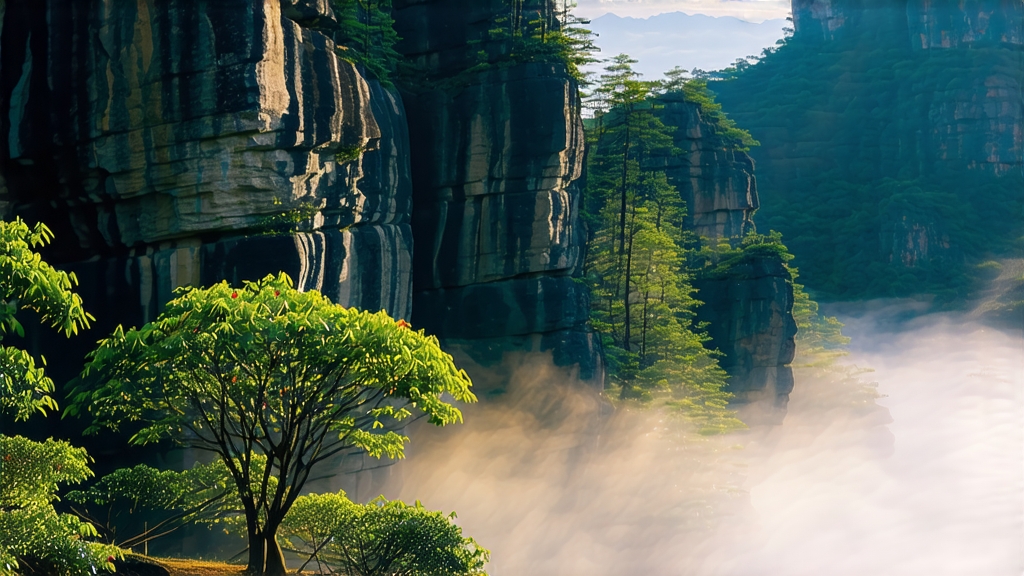
High above the Pearl River delta, where granite peaks tear through subtropical clouds, the Phoenix Mountains of Guangdong have been humming with tea fragrance for almost a thousand years. Among the countless oolongs that China has gifted the world, Phoenix Dancong—literally “Single Bush”—is perhaps the most perfumed, the most individualistic, and the most confounding to master. Unlike the neatly terraced gardens of Fujian or Taiwan, Dancong tea trees are scattered across vertiginous cliffs between 350 m and 1,300 m, rooted in mineral-rich, weathered igneous soil. Each ancient tree is allowed to grow into a natural canopy, often exceeding four metres in height, and is harvested by agile climbers who scale bamboo ladders with woven baskets on their backs. The result is an oolong that carries the scent of wild orchids, ripe lychee, warm honey, almond blossom, or even fresh ginger—depending on which genetically distinct “fragrance type” the tree expresses.
Legend traces Dancong back to the Southern Song dynasty, when imperial examiners tasted a local brew so aromatic they proclaimed it “the tea that carries the fragrance of all flowers.” The Song emperor allegedly granted crimson robes to the mountain’s six most venerable trees, an honor mirrored today by the protected “Song cultivar” group. During the Ming, monks from the nearby Fengxi Temple systematised plucking and charcoal-baking techniques, while Qing-era merchants carried the tea down the Han River to the port of Shantou, launching it onto clipper ships bound for Southeast Asia and Europe. By the 1930s, overseas Chinese communities in San Francisco and Penang were paying premiums for small tins labelled “Fung Huang Tan-chung,” ensuring the tea’s reputation as a luxury diaspora commodity.
Yet “Dancong” is not a single cultivar but a mosaic of over eighty recognised fragrance profiles, each tied to a specific mother tree. The most celebrated include Huangzhi Xiang (orange blossom), Milan Xiang (honey orchid), Yulan Xiang (magnolia), Zhilan Xiang (gardenia), and the elusive “Duck Shit Fragrance”—a name farmers coined to deter thieves who coveted the tree’s particularly sweet, creamy cup. Because the Phoenix range is a biodiversity hotspot, cross-pollination occurs constantly; seedlings express new aromatic signatures, and clonal propagation is deliberately avoided. Every spring, growers therefore trek from tree to tree, tasting leaves and assigning each a fragrance code that will guide the crafting process.
Making Dancong is a six-act drama that begins around Qingming festival, when two leaves and a bud are plucked under the morning mountain mist. The first act, sun-withering, is brief; leaves are laid on bamboo screens for twenty minutes, just long enough for the edges to soften. Indoors, they are gently tossed onto round rattan trays in a step called zuoqing—“making the green.” Here the magic of partial oxidation is coaxed through repeated shakings: five to eight rotations every hour, for up to ten hours, until the leaf margins turn a distinctive russet while the veins remain jade. Master craftsmen listen for a dull, almost metallic rustle—the moment when cell walls have ruptured just enough to release aromatic precursors without bruising the leaf’s integrity.
Next comes shaqing, the kill-green, performed in iron woks heated to 240 °C. A single kilogram of leaves is thrown into each wok; the tea master’s bare hands flip the mass for less than three minutes, halting oxidation at roughly 30 %. The leaves are then rolled—first mechanically to break surface membranes, then by hand along bamboo mats to twist them into the dark, ropey strips that Dancong aficionados recognise. The most critical phase follows: charcoal baking, meihong in local dialect. Using only embers from longan or lychee wood, the tea is baked in shallow bamboo sieves stacked inside a mud-brick oven. Temperature is raised and lowered across three rounds that may span thirty-six hours; between each round the leaves rest for days, allowing moisture deep inside the stem to migrate outward. When executed flawlessly, the process locks in layered florals while adding a whisper of smoked caramel, a signature “mountain rhyme” that lingers in the throat.
To brew Phoenix Dancong well, one must respect its dual nature: it is at once delicate and fiercely concentrated. A 120 ml gaiwan or small Yixing te